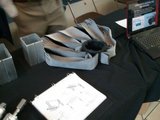
Wow, we've looked at a lot of neat stuff at the SDS. There was the 10-foot plasma-guided rocket, aerodynamic farings for two bicycles, and even a life-size remote control and motion base. But surely not everything can be so exciting?
Today I'll tell you about some of the most mundane things I saw at the SDS. Despite their pedestrian nature, each one is still a real-life problem solved by engineering students. With SCIENCE!
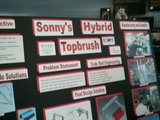
When I saw this, I actually told the student displaying it, "This is the most mundane thing I've seen all day. But I'll bet you can tell me all about the challenges that made it interesting." And he did.
They didn't make any novel materials. They didn't add a computer and program it with an artificial intelligence that will take over the world one day. They didn't even have a huge problem to solve.
But they did have a real-life sponsor with a real-life problem. Sonny's Car Wash wanted a car wash machine that could handle SUVs.
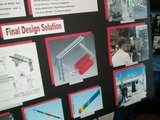
Now, I've never owned or driven an SUV, but the student explained the problem to me: they're too tall and too flat in back. That whirling brush that washes your hood and goes over your roof? When it reaches the back of a sedan, it just slopes on down and cleans everything off. But in an SUV, it kinda drops straight down. You're lucky if it gets the top corner, let alone the whole back and bumper.
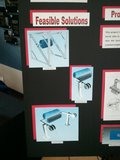
They came up with a counter-weighted assembly with an elliptically rotating brush. It not only rotates on that arm, the arm slides up and down in the tracks. The counterweight makes it so well balanced you can push it up with one finger. The sliding rotation point makes it clean the entire back of the SUV, not just one corner.
It wasn't their first answer, either. Earlier attempts were too cumbersome, too unreliable, or too expensive. But they worked with their customer and came up with an elegant, functional solution. And Sonny's will be installing it this summer, which I think is really cool.
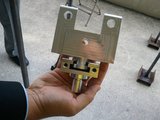
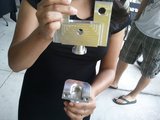
But that wasn't the only "boring" real-life display at the SDS. No! There was also this little device. The student holding it was standing next to some metal frames. When I finally gave in and asked what it was for, the answer was simple: bearing maintenance.
Not just any old bearings, though. GIANT 300 POUND BEARINGS that they use in electrical power generator turbines! Well, it makes sense. Those giant generators must have bearings so the turbine spins smoothly. And even though they're as tall as a man, they still have to be shaped to within a few thousandths of an inch, or the whole thing could fly apart. Of course you're going to have to replace them.
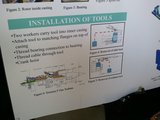

Siemens actually paid them to redesign the existing maintenance system. They've been using a crane on wheels, with a winch on a chain. That new metal bit is a cable-driven trolley that runs in the metal framework I told you about (but don't have a picture of). You run the trolley down to the bearing and detach the "bolt". At this point, the cable runs over the trolley, converting the horizontal motion of the cable to vertical. You attach the bolt to the bearing, then pull the cable up.
When it reaches the trolley, you snap it all together and put in a few retaining pins. When the bolt is firmly attached to the trolley, pulling on the cable results in horizontal motion again, allowing you to pull the bearing past the generator turbine.
Check out the full-size images on the right for a diagram that'll give you a better idea of what's going on. Again, this is a project with a real-world result: Siemens is going to install and use this new design with their turbines.

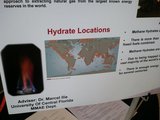
Okay, just one more, then we're done with the mundane stuff.
This weird-looking contraption is a methane extractor. It's not usually hooked up to itself; they've just got it that way to prevent humid air from getting in.
According to their display, there's a lot of methane hydrate in the world. Methane is a natural gas; it's said to be environmentally better than gasoline. Unfortunately, most of it is caught up in methane hydrate, rendering it useless. It's also difficult to extract, because it's usually in slush or methane ice. By the time you get it, it's heated up and evaporated.
This device actually separate the methane and the -hydrate, allowing you to collect fuel from places you couldn't before. If they can scale it up, it could be useful as an alternative to crude oil.
Well, that wraps up the mundane stuff. Next time, we'll be back to big solar collector troughs and oil cleaning robots!